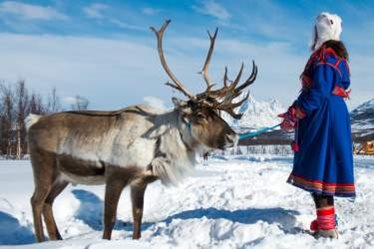
The story of the hardy Sámi — the European Union’s only recognized indigenous people, who inhabit the Arctic regions of Norway, Sweden, Finland, and Russia’s Kola Peninsula — is one of centuries of triumph over harsh environmental and political conditions.
The Roman historian Tacitus called the Sámi, the “Fenni,” from which “Fin” may well have derived, but their existence in the Arctic wilderness of Scandinavia predates Tacitus by many millennia. Unlike their mercantile neighbors in present-day Norway, Sámi were stubbornly self-sufficient, relying on their own environment for subsistence. In addition to fishing and foraging, the Sámi have always relied on reindeer husbandry and herding to provide them with food, clothing, and shelter.
Sámi independence and self-sufficiency saved the nomadic tribe when the bubonic plague swept through the northern countries in 1349. It was carried by plague-infested fleas, who made their homes in grain and wool barrels transported between villages and towns. Since the Sámi relied on their own herds very few of them perished, unlike the tens of thousands of Norwegians who died from plague.
As Christianity became the dominant religion in Scandinavia, the Sámi’s unique shamanistic belief system came under threat. In the Eighteenth Century, Norway, in particular, pursued a consistent policy of taking Sámi children away from their
siida or family units and placing them in Christian boarding schools or with missionary families. In the first half of the Twentieth Century, a systematic plan to use the new science of eugenics to wipe out Sami culture saw thousands of Sami women sterilized.
But the Sami proved tenacious, and today their legal rights, unique culture, and way of life are protected under European Union legislation. The Sámi language, which has over 100 words for “snow,” is alive and well and in use amongst Sámi across Sápmi, the northern sector of the Arctic.
Reindeer husbandry remains the fulcrum of both the Sámi way of life and their economy. Reindeer are the only domesticated deer in the world, used as beasts of burden until as late as World War II when Russian armed forces used them as pack animals from the port of Murmansk out to the front. And of course, the Arctic’s most famous reindeer were given specific names in 1823 for a poem entitled “A Visit from Saint Nicholas.”
The Sámi use every part of the reindeer: drying their meat for consumption, using the skin for shoes and clothing and covers for their Katas, teepee-like dwellings constructed during the summer grazing season. Bones are used for traditional Sámi handicrafts while the antlers are most often sold to the Chinese for use in traditional medicine.
Sámi reindeer are a massive draw for the growing number of travelers interested in exploring the Arctic. Sledge rides and reindeer photo safaris are increasingly popular, as are visits to traditional Sámi communities to learn more about these resilient Arctic people, who have managed to preserve their unique way of life despite steep odds.
Visit a Sámi reindeer farm and enjoy a sledge ride on Alexander + Roberts’s popular
Finland's Lapland itinerary, which is based at the picturesque Kakslauttanen Arctic Resort in Finland’s largest national park. Your comfortable log cabin includes a Kelo-Glass Igloo from which — conditions permitting — you may be able to see the famous Northern Lights!